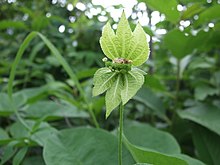Dalechampia
| Dalechampia | |
|---|---|
 |
|
| Dalechampia scandens, Ecuador | |
| Scientific classification | |
| Kingdom: | Plantae |
| (unranked): | Angiosperms |
| (unranked): | Eudicots |
| (unranked): | Rosids |
| Order: | Malpighiales |
| Family: | Euphorbiaceae |
| Subfamily: | Acalyphoideae |
| Tribe: | Plukenetieae |
| Subtribe: | Dalechampiinae |
| Genus: |
Dalechampia L. 1753 |
| Synonyms | |
Dalechampia is a genus of plant of the family Euphorbiaceae and of the monogeneric subtribe Dalechampiinae. It is widespread across lowland tropical areas (generally below 2,000 m ASL) primarily in the Americas with smaller numbers of species in Africa, Madagascar, and southern Asia. Additional new species are still being described and several are very rare and at risk of extinction.
Dalechampia has unisexual flowers that are secondarily united into bisexual blossoms (pseudanthia), which act as the pollination units. The pollination and floral evolution of this genus have been studied more intensively than perhaps any other member of the euphorbia family. In the neotropics (Americas), most species are pollinated by resin-collecting female bees, including euglossine bees and Hypanthidium of the Megachilidae, which use resin in nest construction. About a dozen neotropical species are pollinated by fragrance-collecting male euglossine bees, which use these fragrances to attract females for mating. There are at least three independent pollination shifts from pollination by female resin-collecting bees to pollination by male fragrance-collecting bees. African and Asian species are also pollinated by resin-collecting megachilid bees, but Malagasy species are pollinated by pollen-feeding beetles and pollen-collecting bees.
Two species are of horticultural interest, D. spathulata and D. aristolochiifolia, have particularly showy blossoms with bright pink/purple bracts. Dalechampia aristolochiifolia, from Peru, has become very popular recently, but it is mistakenly advertised and distributed under the name D. dioscoreifolia.
...
Wikipedia
